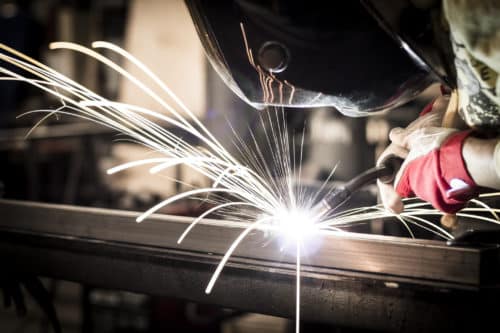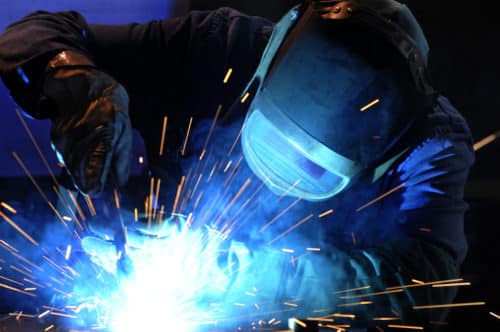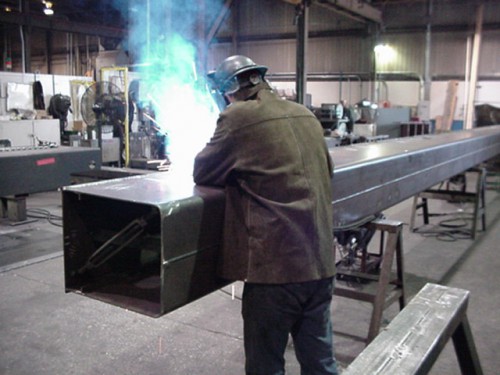
GMAW operations use two types of gases—inert or active—each of which characterizes one of the process’s two forms: MIG and MAG. Metal inert gas (MIG) welding uses inert gas during the welding process, while metal active gas (MAG) welding uses active gas. In addition to being categorized based on the assist gas employed, GMAW operations can also be classified based on their modes of transfer.
Although GMAW typically uses a constant voltage and direct current power system, the process also employs alternating current systems with a range of different amps and voltages and varying electrode diameters. Additionally, depending on the requirements and restriction of the welding application, GMAW can be configured to be semi-automatic—i.e., require some human operator involvement—or fully automatic with mechanized control. These options make the process a viable solution for a wide range of fastening applications.
Transfer Modes of GMAW
As noted above, GMAW uses different metal transfer modes. Each mode offers distinct characteristics and best use cases and is largely dependent on the specific welding process, power supply, and consumable employed. A variety of factors influence which transfer mode should be used for a GMAW application, including the amount and type of current, electrode chemistry, surface, and diameter, type and delivery of shielding gas, and contact-to-workpiece distance. The choice of transfer mode affects which filler metal is ideal.
The four modes of GMAW transfer include:
- Globular. This mode uses CO2 shielding gas, which is less expensive than other shielding gases such as argon. Although it offers a higher deposition rate that allows for faster welding speeds, it generates more heat than other modes, resulting in uneven weld surfaces and greater spatter production. To combat these disadvantages, welding operations that use the globular metal transfer mode require thicker materials and entirely flat positioning.
- Short-Circuiting. Welding operations that use the short-circuiting metal transfer mode are also referred to as short arc GMAW or SCT. In this transfer mode, short-circuiting occurs as the electrode contacts the workpiece, providing transfer rates of between 20 and 200 times per second. It uses a mixture of 75% argon and 25% CO2 or three-part gas mixtures as its shielding gas and can be used for thin (less than ¼ inch) stock of ferrous metals and pipes without backing.
- Spray. In the spray transfer mode, molten droplets of material—usually smaller than the diameter of the electrode—spray across the workpiece. This mode uses a variety of mixtures from 80% to 98% argon with 2% to 20% CO2 and requires higher voltage or amperage, faster wire feed rates, thicker materials, and horizontal or flat positioning.
- Pulse-Spray. The main characteristic of this mode is an alternation between a high voltage spray current and a low background current. This quality enhances the spray transfer process by supercooling the weld pool during the low current cycle and reduces heat generation and distortion.
Advantages of GMAW
Each of the transfer modes provides its own advantages in specific applications. However, there are some general advantages associated with using gas metal arc welding, including:
- Ability to be configured for semi-automatic or fully automated operation
- Versatility regarding material and joint thickness
- Ease of cleanup and lack of chipping
- Welding position flexibility
- Cost-effectiveness
- Process speed
- Environmental friendliness (minimal waste is produced as electrodes are fully consumed)
Applications of GMAW
GMAW arose as a solution for welding aluminum and other non-ferrous materials. However, due to its capacity to speed up the welding process, its use has spread to steel and stainless steel applications. Its versatility allows for its use in any industry and with a wide range of materials. Some of the most common applications for GMAW include:
- Automotive production and maintenance operations
- Robotic assembly lines
- Pipe fitting
- Track construction and maintenance operations in the railway industry
Contact G.E. Mathis Company for Your GMAW Needs
At G.E. Mathis, we offer precision arc and MIG welding services to customers across a broad range of industries, including agriculture, mining, aerospace, military, and construction. Armed with a state-of-the-art facility and years of industry experience, our team of highly skilled welders has the tools and expertise necessary to offer a variety of welding services. In addition to GMAW, we provide:
- Dual wire submerged arc/MIG Welding
- Flux core arc welding (FCAW)
- Gas tungsten arc welding (GTAW)
- Seam welding
- Shielded metal arc welding (SMAW)
- Submerged arc welding (SAW)
Located in Chicago, Illinois, our 135,000 square foot facility—equipped with fully automated, CNC-controlled welding equipment—allows us to meet virtually any customer specifications on high precision, large volume projects. Our capabilities include:
- Production capacities for large weldments up to 12 feet wide or 80 feet long with the tightest tolerances available in the industry
- Material capabilities for a wide range of metals, such as carbon steel, stainless steel, HARDOX® Wearplate, STRENX®, and other alloys
To ensure the quality of our products, both our personnel and facilities maintain compliance with the highest certification standards, such as AWS D1.1, D1.6, D9.1, and D10.9.
In addition to being an ISO 9001:2015-certified manufacturer, G.E. Mathis Company can provide the following services:
- PPAP (Production Part Approval Process) – All Levels
- FAIR (First Article Inspection Report)
- Capability Studies (Statistical Process Control)
- CMRT (Conflict Minerals Reporting Template)
Contact us today for more information about our gas metal arc welding capabilities or request a quote from one of our experts for your next project.















